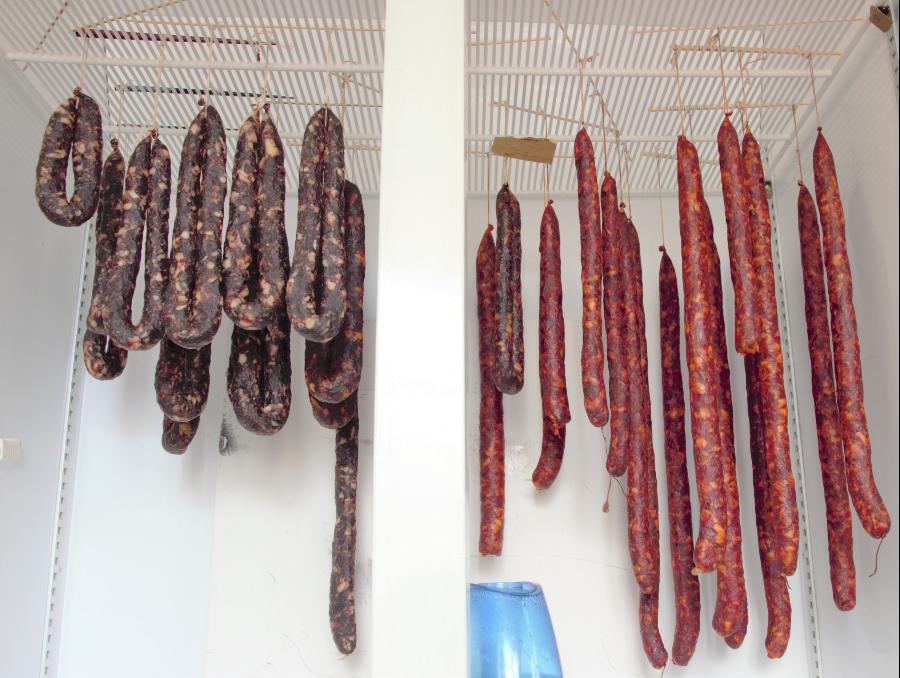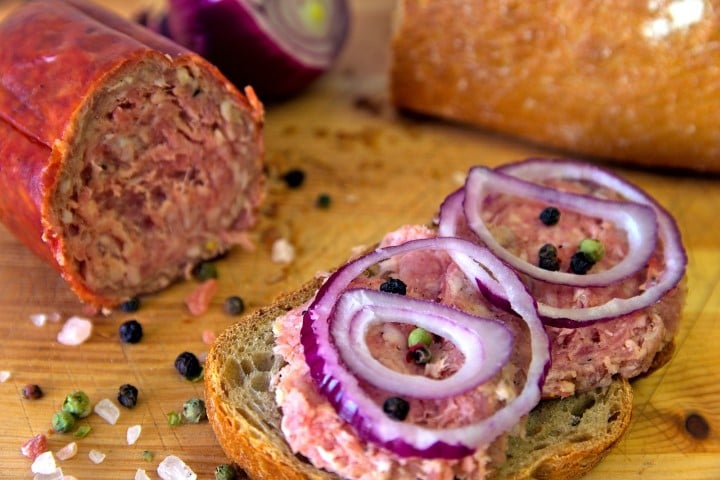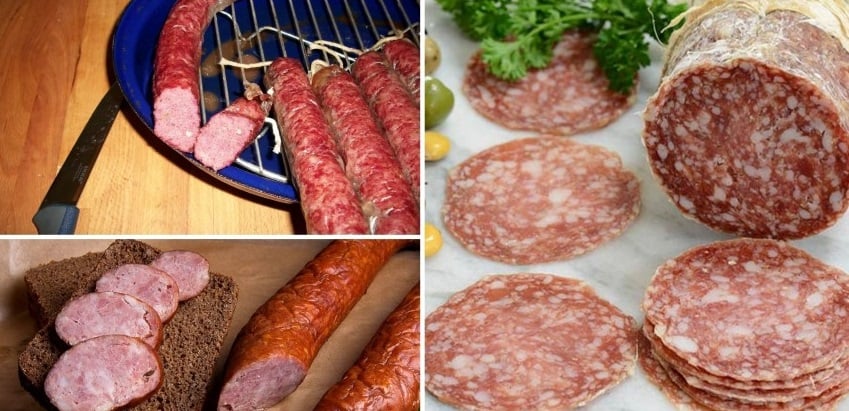Not all sausages are cured, so I want to review what a cured sausage is because I get many questions of confusion over what curing and making sausage is. It’s perceived differently everywhere.
Believe it or not, after a few decades of making, eating, and looking up cured sausages worldwide. I still am amazed at the variations of cured sausages.
Often, it’s due to the misunderstanding of what curing is. Yet, the meaning of ‘uncured‘ differs in America or anywhere else in the world – there is a government labeling rule – I’ll go into that later.
Sausages come in thousands of variations everywhere: fresh raw sausage, cured, dried, or cooked/smoked.
Although another type exists, I will go over, is spreadable cured sausage!
What Makes a Sausage “Cured”?
Curing involves adding salt to fresh sausage meat and sometimes nitrates/nitrites. Cured sausages have a certain amount of salt to inhibit the meat and reduce unwanted bacteria through binding and diffusion. Often the goal is to dry and preserve the sausage, in some instances, the sausage is fermented which decreases pH and increases acidity.
Understanding the Curing Process
Curing is the first step: we have dry curing and wet curing (or brining). The meat is cured in a salt-based dry or wet environment. To cured sausages, salt is added to the ground or minced meat.
Depending on the amount of salt, it’s either more for drying/preserving or less for curing/fermenting/raw or hot smoked (here is a link to the hot smoking category list on this site), as in table below:
For at-home cured sausages, I use 2% – 2.5% for dry-cured salami sausage curing.
Or 1.25-1.5% for uncured fresh sausage, which will be looked up later.
Different Types of Cured Sausage
Fresh sausages have a lower content of salt and spices. They are like meat patties in a sausage shape. Then, for cured sausages with a few variations, see the table below to demystify them.
| Type | Example | Time to Make |
|---|---|---|
| Cured, Fermented, Dried | Dry Cured Salami | 4 weeks to 6 months |
| Cured, Cold Smoked, Dried | Hungarian KOLBÁSZ Salami | 4-8 weeks |
| Cured, Fermented, Raw | Spreadable streichfähige Mettwurst | 1 day |
| Cured, Cooked/Hot Smoked | Kabanosy, Cabanossi, or Kabana | 1 day |
Examples of Cured Sausages Explained
Let’s go over the above examples and elaborate on the process better to understand the varied interpretations and styles of cured sausage!
Dry-Cured Fermented Salami: A Classic Example

What most Western folk will be familiar with is mass-produced commercial styles, maybe not so much the traditional artisanal. A mass-produced salami, for example, is often forced with chemicals in the sausage to become acidic very quickly and can be produced in a few days.
Above are the traditional artisanal salami types from a place like Italy. Sometimes, it is also produced in large-scale volumes.
Curing involves salt, nitrates/nitrites (often)
Some will say that also spices & starter culture are part of curing. My definition is that curing is salt to inhibit the meat and prevent unwanted bacteria, and nitrates/nitrites also perform this role against botulism.
Spices & Herbs can have antibacterial, viral, and fungal effects in preserving and, of course, flavoring.
Starter Culture can be introduced (or can naturally occur) to create lactic acid, lowering the pH and increasing acidity.
For artisanal salami, with TIME, the flavors are combined, and factors and some reactions are happening to create complex and desirable flavors (probably also with traditional recipes that have lasted hundreds, if not thousands, of years).
Cold Smoked and Dried: Hungarian KOLBÁSZ Salami

Above are the Hungarian-style Salamis I make.
Curing with salt and cold smoked for 15 hours, reducing the weight by at least 30% – my preference is 40%. These are the Hungarian-style salamis I make.
Some more traditional cured salami sausages from Eastern Europe are not fermented; this may also be due to the colder climate in winter when salamis are traditionally made.
Uncured has been confused by a labeling law stating uncured meat has a naturally derived form of nitrate/nitrite. The rest of the world sees uncured as not having a salt/nitrite process, like a fresh raw sausage you fry on the grill/BBQ.
We get into cured spreadable cold smoked raw sausages from Italy, specifically Southern Italy, Calabria came up with a Dry Salt Cured, Cold Smoked, and DRIED sausage – a spreadable salami, Nduja!
Fermented and Raw Sausage: Spreadable Cold Smoked Mettwurst

German Mettwurst is a cured, spreadable, cold-smoked, raw sausage.
Hackepeter is raw fresh pork mince seasoned on bread This seems at odds with many sausage processes.
Salt and spices are added to cure the minced meat. It’s then cold smoked (under 86°F/30°C) for flavor and some small amount of protection on the surface. It’s then kept cold/refrigerated, smeared onto bread, and consumed!
A very small amount of drying would occur during the cold smoking process.
Since it has salt, it does extend the refrigerated shelf life, but only a week or so – longer – I would not recommend it.
An emulsified version of this cured sausage would be Teewurst. Another name I found for a similar style is Metka, which could also be related to liverwurst! Some of these types of sausages can be kept in a jar, though 1-2 weeks would be the longest they last.
Dutch Metworst (or droge worst – translates to dry sausage in Dutch) is a dry-cured salami. Sounds similar, but very different!
Cooked/Hot Smoked Sausage: Kabanosy, Cabanossi, and Kabana

Hot Smoked Examples on the left, and Dry-Cured Salami on the right.
There is another cooked product with a difference. This sausage is cooked at a low temperature that is ideal, because it does not render down as much as cooking a pork chop or other fresh meat.
The curing of the sausage is more toward taste as opposed to inhibiting the bacteria.
After this, it is cured, cooked, and hot smoked.
When kept at a cold or refrigerated temperature, they may last a week or two.

Tom Mueller
For decades, immersed in studying, working, learning, and teaching the craft of meat curing, sharing the passion and showcasing the world of charcuterie and smoked meat. Read More
